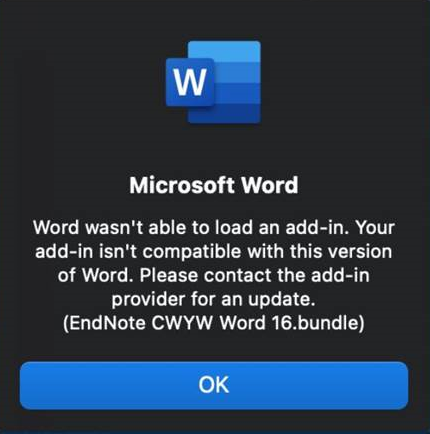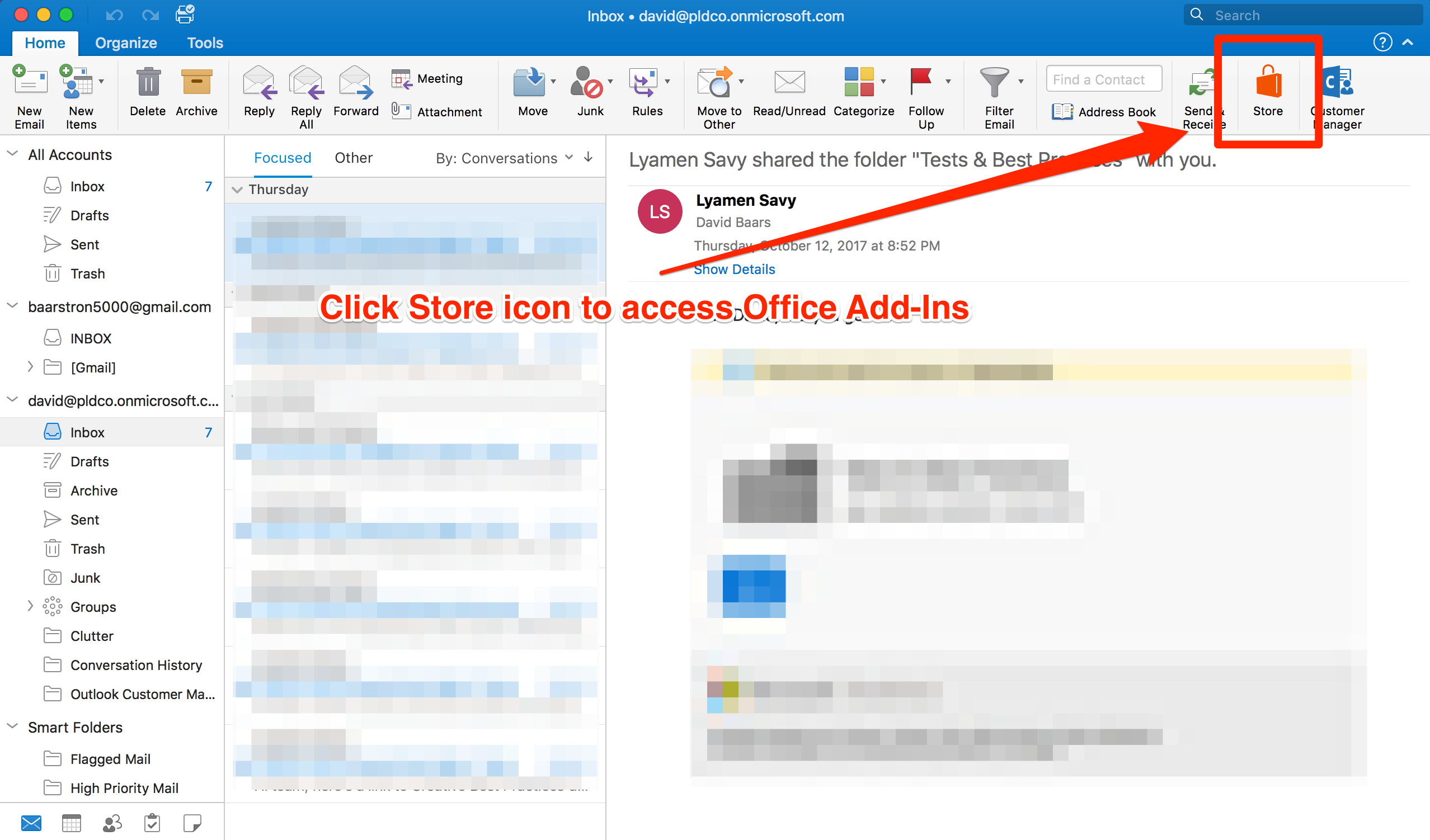Error Loading Add-ins Word For Mac 2016
- Error Loading Add-ins Word For Mac 2016 Version
- Error Loading Add-ins Word For Mac 2016
- Error Loading Add-ins Word For Mac 2016 Download
- Error Loading Add-ins Word For Mac 2016 Free
In Excel, choose ToolsTemplates and Add-ins. In the Global Templates and Add-ins section, select the problem add-in. Make a note of its location under Full path:, then close Excel. In the Finder, hold down the Alt key while clicking on the Go menu and choosing Library. Your user library folder will open. However, in Word, I do not see it under 'add-ins' ribbon. I do see that there are multiple add-in versions for Mendeley. I tried to attach an image to this message, but it would not attach. However, every time I try to uncheck and delete these, Word crashes. It also crashes every time I quit Word.
At times your users might encounter issues with Office Add-ins that you develop. For example, an add-in fails to load or is inaccessible. Use the information in this article to help resolve common issues that your users encounter with your Office Add-in.
You can also use Fiddler to identify and debug issues with your add-ins.
Common errors and troubleshooting steps
The following table lists common error messages that users might encounter and steps that your users can take to resolve the errors.
| Error message | Resolution |
|---|---|
| App error: Catalog could not be reached | Verify firewall settings.'Catalog' refers to AppSource. This message indicates that the user cannot access AppSource. |
| APP ERROR: This app could not be started. Close this dialog to ignore the problem or click 'Restart' to try again. | Verify that the latest Office updates are installed, or download the update for Office 2013. |
| Error: Object doesn't support property or method 'defineProperty' | Confirm that Internet Explorer is not running in Compatibility Mode. Go to Tools > Compatibility View Settings. |
| Sorry, we couldn't load the app because your browser version is not supported. Click here for a list of supported browser versions. | Make sure that the browser supports HTML5 local storage, or reset your Internet Explorer settings. For information about supported browsers, see Requirements for running Office Add-ins. |
When installing an add-in, you see 'Error loading add-in' in the status bar
- Close Office.
- Verify that the manifest is valid
- Restart the add-in
- Install the add-in again.
You can also give us feedback: if using Excel on Windows or Mac, you can report feedback to the Office extensibility team directly from Excel. To do this, select File | Feedback | Send a Frown. Sending a frown provides the necessary logs to understand the issue.

Outlook add-in doesn't work correctly
If an Outlook add-in running on Windows and using Internet Explorer is not working correctly, try turning on script debugging in Internet Explorer.
Go to Tools > Internet Options > Advanced.
Under Browsing, uncheck Disable script debugging (Internet Explorer) and Disable script debugging (Other).
We recommend that you uncheck these settings only to troubleshoot the issue. If you leave them unchecked, you will get prompts when you browse. After the issue is resolved, check Disable script debugging (Internet Explorer) and Disable script debugging (Other) again.
Add-in doesn't activate in Office 2013
If the add-in doesn't activate when the user performs the following steps:
Signs in with their Microsoft account in Office 2013.
Enables two-step verification for their Microsoft account.
Verifies their identity when prompted when they try to insert an add-in.
Verify that the latest Office updates are installed, or download the update for Office 2013.
Add-in dialog box cannot be displayed
When using an Office Add-in, the user is asked to allow a dialog box to be displayed. The user chooses Allow, and the following error message occurs:
'The security settings in your browser prevent us from creating a dialog box. Try a different browser, or configure your browser so that error-loading-add-ins-word-for-mac-2016.html and the domain shown in your address bar are in the same security zone.'
| Affected browsers | Affected platforms |
|---|---|
| Internet Explorer, Microsoft Edge | Office on the web |
To resolve the issue, end users or administrators can add the domain of the add-in to the list of trusted sites in Internet Explorer. Use the same procedure whether you're using the Internet Explorer or Microsoft Edge browser.
Important
Do not add the URL for an add-in to your list of trusted sites if you don't trust the add-in.

To add a URL to your list of trusted sites:
- In Control Panel, go to Internet options > Security.
- Select the Trusted sites zone, and choose Sites.
- Enter the URL that appears in the error message, and choose Add.
- Try to use the add-in again. If the problem persists, verify the settings for the other security zones and ensure that the add-in domain is in the same zone as the URL that is displayed in the address bar of the Office application.
This issue occurs when the Dialog API is used in pop-up mode. To prevent this issue from occurring, use the displayInFrame flag. This requires that your page support display within an iframe. The following example shows how to use the flag.
See also
-->You can use runtime logging to debug your add-in's manifest as well as several installation errors. This feature can help you identify and fix issues with your manifest that are not detected by XSD schema validation, such as a mismatch between resource IDs. Runtime logging is particularly useful for debugging add-ins that implement add-in commands and Excel custom functions.
Note
The runtime logging feature is currently available for Office 2016 or later on desktop.
Important
Runtime Logging affects performance. Turn it on only when you need to debug issues with your add-in manifest.
Use runtime logging from the command line
Enabling runtime logging from the command line is the fastest way to use this logging tool. These use npx, which is provided by default as part of npm@5.2.0+. If you have an earlier version of npm, try Runtime logging on Windows or Runtime logging on Mac instructions, or install npx.
To enable runtime logging:
To enable runtime logging only for a specific file, use the same command with a filename:
To disable runtime logging:
To display whether runtime logging is enabled:
To display help within the command line for runtime logging: Utorrent download for pc windows 10.
Runtime logging on Windows
Make sure that you are running Office 2016 desktop build 16.0.7019 or later.
Add the
RuntimeLoggingregistry key underHKEY_CURRENT_USERSOFTWAREMicrosoftOffice16.0WEFDeveloper.Note
If the
Developerkey (folder) does not already exist underHKEY_CURRENT_USERSOFTWAREMicrosoftOffice16.0WEF, complete the following steps to create it.- Right-click the WEF key (folder) and select New > Key.
- Name the new key Developer.
Set the default value of the RuntimeLogging key to the full path of the file where you want the log to be written. For an example, see EnableRuntimeLogging.zip.
Note
The directory in which the log file will be written must already exist, and you must have write permissions to it.

The following image shows what the registry should look like. To turn the feature off, remove the RuntimeLogging key from the registry.
Runtime logging on Mac
Make sure that you are running Office 2016 desktop build 16.27 (19071500) or later.
Open Terminal and set a runtime logging preference by using the
defaultscommand:<bundle id>identifies which the host for which to enable runtime logging.<file_name>is the name of the text file to which the log will be written.Set
<bundle id>to one of the following values to enable runtime logging for the corresponding application:com.microsoft.Wordcom.microsoft.Excelcom.microsoft.Powerpointcom.microsoft.Outlook

The following example enables runtime logging for Word and then opens the log file:
Error Loading Add-ins Word For Mac 2016 Version
Note
You'll need to restart Office after running the defaults command to enable runtime logging.
To turn off runtime logging, use the defaults delete command:
The following example will turn off runtime logging for Word:
Use runtime logging to troubleshoot issues with your manifest

To use runtime logging to troubleshoot issues loading an add-in:
Error Loading Add-ins Word For Mac 2016
Sideload your add-in for testing.
Note
We recommend that you sideload only the add-in that you are testing to minimize the number of messages in the log file.
If nothing happens and you don't see your add-in (and it's not appearing in the add-ins dialog box), open the log file.
Search the log file for your add-in ID, which you define in your manifest. In the log file, this ID is labeled
SolutionId.
Known issues with runtime logging
You might see messages in the log file that are confusing or that are classified incorrectly. For example:
Error Loading Add-ins Word For Mac 2016 Download
The message
Medium Current host not in add-in's host listfollowed byUnexpected Parsed manifest targeting different hostis incorrectly classified as an error.If you see the message
Unexpected Add-in is missing required manifest fields DisplayNameand it doesn't contain a SolutionId, the error is most likely not related to the add-in you are debugging.Any
Monitorablemessages are expected errors from a system point of view. Sometimes they indicate an issue with your manifest, such as a misspelled element that was skipped but didn't cause the manifest to fail.